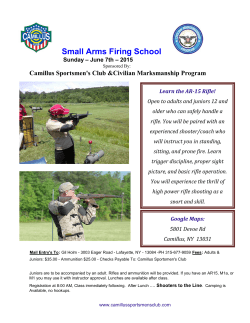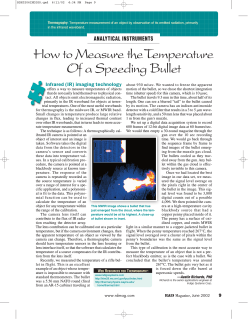
View PDF
Bridging the Gap: The New Short Action .338 Federal by Ken Kempa Launched at SHOT Show in early 2006, the author takes a look at the new .338 Federal cartridge. Filling the ballistic void between the classics- the 308 Winchester/ 30-06- and the workhorse .35 Whelen, it has the potential to give the serious hunter more raw power in the field, without punishing your shoulder. For the seekers of medium to heavy game, most all taken in the field are within 300 yards or less; more often than not, at half or less that distance. For this task, you do not need a cartridge burning 75 or more grains of powder, with the attendant increase of recoil. What is needed is a slightly larger caliber, shooting heavier bullets, at more typical standard cartridge speeds. Apparently Federal Cartridge thought the very same thing, as they teamed up with Sako/Tikka to develop and present to serious hunters, a very sensible medium bore, short rifle action cartridge, the .338 Federal. It is the first cartridge to ever bear their name. No need to reinvent the wheel, as the offspring of the classic .308 Winchester cartridge have been doing just fine for decades- the 243, 260, 7mm-08, and the 358 versionsFederal basically opened up the parent case to .338 diameter. This helped to ensure the same trouble-free feeding from short action rifles. The .338 caliber has advantages over the much older .358, in that the sectional density of like-weight bullets is higher in the .338, and also sport higher ballistic coefficients, for deeper penetration, with flatter trajectories and higher remaining velocities at all ranges. The huge popularity of the .338 caliber has also resulted in a much wider range of bullets, in regards to weights and styles, from most every manufacturer. This serves to enhance shooter acceptance, and also affords the hunter the ability to specifically tailor his loads to the game being taken. As most cartridges of this caliber are much larger magnums, meant for taking game up close or far away, excellent bullet performance at the slower speeds of the .338 Federal is already “built in” to the products. A hit from a magnum way out yonder, will have the same impact performance of a close to moderate range shot taken with the more modest and sensible Federal round. Small bore magnums have to rely on ultra-high speed for performance, while the medium bores enjoy the benefits of the impact of larger, heavier bullets to deliver game getting performance. Any hunter, who can shoot the 30-06, can easily handle the comparable recoil of the Federal round. So if you are a serious hunter, taking your shots within 300 yards or less, both you and your game will be impressed with the impact of the .338 Federal. The Test Rifle As this is being written, six months has passed since a request was first made to Sako/Tikka for a test rifle in the new .338 caliber; to date, there has been no indication of when one will be received. Fortunately, Ruger came thorough a new model in the designation of the M77 Hawkeye. It comes in two versions- blued/walnut or stainless/black synthetic; the latter was chosen for this test. The stainless metal has an attractive non-reflective, matte bead blast finish. The stock has molded in checkering for a positive grip in foul weather. The new almost ¾” thick recoil pad is far more effective than the traditional red hard rubber pad usually seen on Ruger rifles. A steel floorplate is now standard, with an improved release for easy unloading; it also sports an attractive Ruger logo. Overall, the rifle carries well and has a solid feel. While the recoil of the .338 Federal compares closely to the 30-06, I feel a slightly heavier barrel would be appreciated by most shooters, than the sporter weight 22” long version as supplied. Also new on the rifle, is the Ruger LC6 trigger, for an “improved out-of-the-box trigger pull” per their literature. My test rifle broke at around 4 lbs, with a bit of travel. A Leupold 3-9x40mm scope was mounted in the Ruger supplied rings. It held up well during the almost 800 rounds shot through it during my testing. Factory Ammo Performance Federal offered the 338 cartridge right from the start with three loadings for the first cartridge to bear their name. At 2,763 fps the 180-grain Nosler AccuBond load would be great for deer, black bear or elk, out to 300 yards or so. It proved to be the most accurate of the three, shooting into just over an inch- 1.06” to be exact, for three shots at 100 yards. It expanded nicely to 0.59”, while retaining 78% of its weight. The second, slightly slower load features a 185-grain Barnes TSX bullet at an actual 2,707 fps, still shooting well at 1.22”. In the field, where it really matters, this bullet has been shooting broadside through bull elk. With performance like this, why should a hunter require a heavier X-Bullet…or a larger cartridge burning more powder for greater speed? After all, completely through is all you would need. It expanded during testing to 0.71” across the petals, while retaining 100% of its weight. The third load features the classic Nosler 210-grain Partition bullet. This is one of the most popular elk bullets used by hunters in the larger .338 cartridges. While slower at 2,513 fps, it delivers similar energy to the Barnes load. The Partition expanded to 0.63”, and held onto 87% of its starting weight. Federal has now added a less costly fourth load, featuring a 200 grain Fusion bullet, but now was available at the time of testing. It also features a bonded jacket like the AccuBond load (though manufactured through a different process). With all of these offerings, hunters are sure to find a good load appropriate for the game being hunted. Reloading the .338 Only new Federal brass was used during my testing, with their 210 Large Rifle Match primers. All reloading was done on a Redding UltraMag press, using their Full Length die set, and Imperial Sizing Die Wax. The FL decapping stem includes a tapered plug, so regular 308 cases could be expanded up, if no Federal 338 brass was available. Simply swirl a cotton swab lightly in the sizing wax, and swirl/coat the neck inside, and then run up over the tapered expander plug. You can then remove all traces of the lubricant, also using a swab, but one sprayed with brake/carburetor cleaner. Due to the broad range of bullet weights tested, running from the 160-grain Barnes X to the 300-grain Woodleigh, twelve powders with different burning rates were tested. Charge weight ran from only the low 30’s to just over 50 grains, so a pound of precious powder will load from 140 to over 210 rounds- pretty miserly! The 160-grain Barnes is a bullet that will usually retain 100% of its weight, giving penetration equivalent to a much heavier soft point bullet. A friend of mine actually used this bullet to take a New Mexico Oryx/Gemsbok with one round. A broadside shot at less than 100 yards penetrated completely, shattering the far side upper leg bone, and leaving large pieces of bone outside on the ground. Hodgdon’s H335 was the powder he used to harvest the Oryx, giving him just over 2,900 fps. Slightly more accurate, but plenty fast for hunting out to 250+ yards, would be rounds using Varget or BL-C2. Excellent low recoil practice and hunting ammunition can be assembled using Accurate 5744, and H4227 or H4198. The last two powders duplicate or exceed standard .308 Winchester ammunition, but with lower recoil. They would be excellent for the young or beginning hunter, or for those shooters who may be recoil shy, or have medical considerations. Stepping up to the 180-grain Nosler Ballistic Tip, you can choose either BL-C2 or Accurate 2460, to duplicate the speed and accuracy of the AccuBond factory load. An all-around favorite, the Barnes 185-grain TSX was the overall most accurate bullet, using either Varget, 2460 or 2520 powders. This bullet in the field has given complete broadside penetration on elk, out to 300+ yards. Realistically, every season a lot of elk are taken at half that distance, or even less. The traditional 200-grain Hornady SP favored 2520 for just under one-inch groups, at a speed of 2,575 fps. Of more standard construction, it offers an economical way to practice with a full-power load, over the more advanced Barnes TSX or Nosler Partition, premium hunting bullets. Accurate 2460 again proved to offer very good precision, when loading the 210-grain Barnes TSX. This bullet probably would provide all the penetration a hunter would ever require for boar or moose, out to moderate ranges. The classic Nosler 210-grain Partition shoots very accurately with a modest charge of Accurate 2015, or for slightly more velocity and power, Hodgdon BL-C2. A very accurate load was developed using H335 under the still heavier 225-grain Partition, for just over 2,450 fps with 0.55” grouping. The equal weight Barnes TSX preferred 2520 powder, for just under one-inch groups at 2,442 fps. This probably would be the ultimate load for deep penetration in large or heavy game, out to medium ranges. A great woods/dark timber load using a traditional round nose, soft point bullet, again uses 2520 powder for just over 2,300 fps with the Hornady 250-grain projectile. You can duplicate the energy level of the 210-grain factory load, by using the 250-grain Woodleigh RNSP with either 2520 or Hodgdon H380. African bound hunters should carry some 250-grain Barnes solids, just in case, duplicating traditional .458 Winchester or Lott velocities, powered by BL-C2 or 2520. Lastly, the awesome looking 300-grain Woodleigh WeldCore projectile can fill the need for hunters wanting the heaviest bullet they can possibly carry into the field. Accurate 2520 would be a great choice, or even H380 for driving those long bullets, to produce almost 2,100 fps. Summary of Performance As most hunting for larger, heavier game occurs in forested areas, where shots are most always well under 200 yards, hunters wanting more knock-down power, might be better served by going to a larger caliber, shooting heavier bullets. The .338 Federal offers just that very thing, without making the jump to the larger case .35 Whelen, and having to pay a much greater price, in terms of recoil, and carrying a longer, heavier rifle. With lighter weight premium bullets, the Federal round also serves the needs of those hunting medium or lighter game, out to longer ranges, without giving up anything to the much lighter, but faster small bores. A hunter armed with the new .338, carefully choosing his loads and bullets, could most certainly hunt for the rest of his life, and never regret his decision. The popular, insightful phrase, “beware of the hunter with only one rifle,” could very well be speaking of a seasoned or beginning shooter, who has selected the new .338 Federal cartridge.
© Copyright 2025









